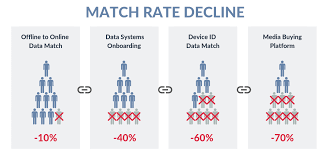
What is the Match Rate?
It refers to the percentage of ad impressions that are successfully matched with a user’s cookie or device ID. The match rate is an important metric for advertisers and publishers because it determines how effective their advertising campaigns will be.

Secrets to Perfecting Match Rate
- Data accuracy: The quality and accuracy of user data are crucial for matching ad impressions to specific users. If the data is incomplete, outdated, or inaccurate, it can lead to lower match rates. Ensuring data accuracy is essential for optimal cookie persistence and effective tracking.
- Cookie and device tracking: In order to match ad impressions to specific users, ad tech platforms use cookies or device IDs to track user behavior. However, if users delete their cookies or use multiple devices, it can make it more difficult to match ad impressions. Effective cookie persistence strategies can help mitigate this issue.
- Ad fraud: Ad fraud is a major issue in the ad tech industry and can negatively impact match rates. Fraudulent traffic, such as bot traffic or click fraud, can result in wasted ad spend and lower match rates. Programmatic ad fraud specifically can manipulate ad bidding processes, leading to inefficiencies and financial losses. Utilizing robust fraud detection tools is crucial to combating these challenges.
- Ad blocker usage: Ad blockers can prevent ad tech platforms from tracking user behavior, which can lead to lower match rates.
- Privacy regulations: Privacy regulations such as GDPR and CCPA require companies to obtain user consent before collecting and using their data. If users choose to opt-out of tracking, it can result in lower match rates. Utilizing effective cookie persistence strategies and monitoring ad fraud can help mitigate these impacts.
- Bidding strategies: Bidding strategies that affect the competitiveness and attractiveness of your bids. These strategies can include your bid price, frequency cap, budget allocation, creative optimization, and targeting criteria. These strategies can determine how often and how well your bids match the available ad inventory and user preferences. To solve these issues, you should test and optimize your bidding strategies regularly, and use data and analytics to inform your decisions. For example, you can use machine learning algorithms, such as reinforcement learning or multi-armed bandits, that can dynamically adjust your bids based on the feedback and outcomes of previous bids.
Overall, the match rate in the ad tech industry depends on a variety of factors, including the quality and accuracy of user data, tracking methods, ad fraud, ad blocker usage, and privacy regulations.
How can Publishers and SSP’s increase their Match rate:
Map first-party information to alternative scaled identifiers :
- Example : When serving personalized ads or content, the platform can use these alternative identifiers to target users based on their purchase history, preferences, or loyalty status, without relying on third-party cookies.
- Hashed Email: The platform can hash the user’s email address to create a unique identifier. For example: Hashed Email for “[email protected]”: abcd1234efgh5678
- Device Fingerprint: Utilizing device fingerprinting, the platform can create an identifier based on various device attributes. For example: Device Fingerprint: xyz7890uvw2345
Encourage User Registrations:
- Example: Publishers can offer user accounts with personalized benefits. For instance, a news website may allow users to create accounts to receive tailored news updates. The registration process can provide valuable user data, increasing the accuracy of matching.
Implement Cross-Device Tracking Techniques:
- Example: Utilize deterministic methods like user logins (e.g., requiring users to log in across devices) and probabilistic methods like device fingerprinting to link user activities seamlessly across different devices. This helps in achieving more accurate matches even when users switch between devices.
Leverage First-Party Data:
- Example: Publishers can incentivize users to provide additional information by offering exclusive content, discounts, or personalized experiences. This first-party data enrichment can significantly enhance user profiles, improving the match rate.
Optimize Cookie and Device ID Persistence:
- Example: Ensure that cookies and device IDs persist across sessions to maintain continuity in user tracking. This reduces the likelihood of losing track of users who revisit a website after initially interacting with an ad. Effective cookie persistence strategies are essential for maintaining high match rates.
Utilize Progressive Profiling:
- Example: Instead of asking users for a large amount of information upfront, employ progressive profiling. Gradually collect more data over time as users engage with the platform. For example, an e-commerce site may initially ask for basic preferences and later seek more detailed information as users make purchases.
Collaborate with Trusted Third-Party Data Providers:
- Example: Partner with reputable data providers to supplement existing user profiles. This collaboration can enhance the depth of user information, resulting in more precise matches. For instance, a lifestyle magazine could collaborate with a demographic data provider to better understand its audience.
Optimize Ad Creative Relevance:
- Example: Ensure that ad creatives are relevant and engaging to the target audience. Tailor ad content based on user preferences and behaviors to increase the likelihood of users interacting with the ad. For instance, an online travel agency might showcase destination-specific ads based on a user’s past travel interests.
Regularly Monitor and Combat Ad Fraud:
- Example: Utilize fraud detection tools and actively monitor for irregular patterns in traffic. For instance, publishers can regularly analyze traffic sources and patterns, identifying and blocking suspicious activities that may artificially inflate impression counts.









